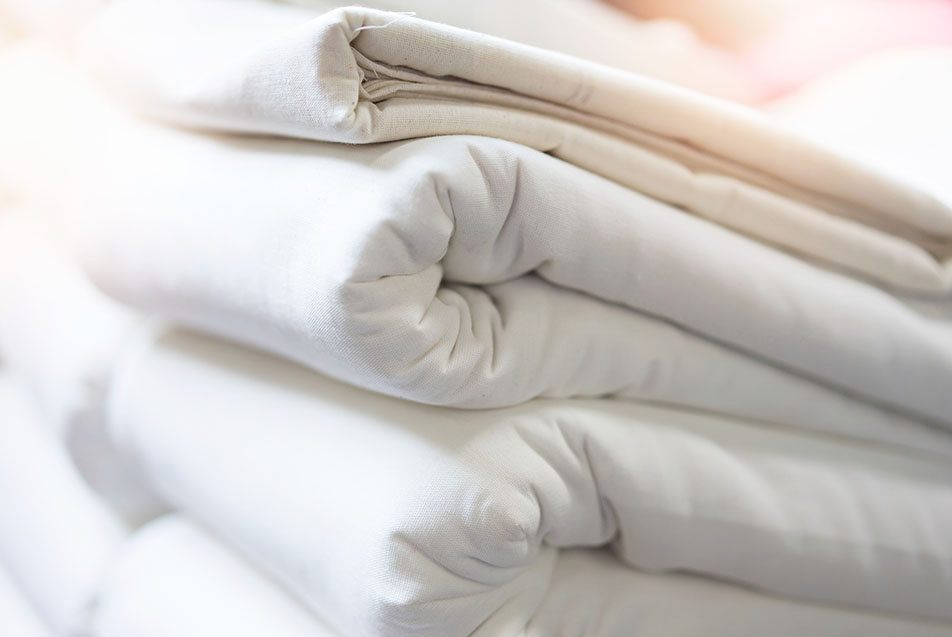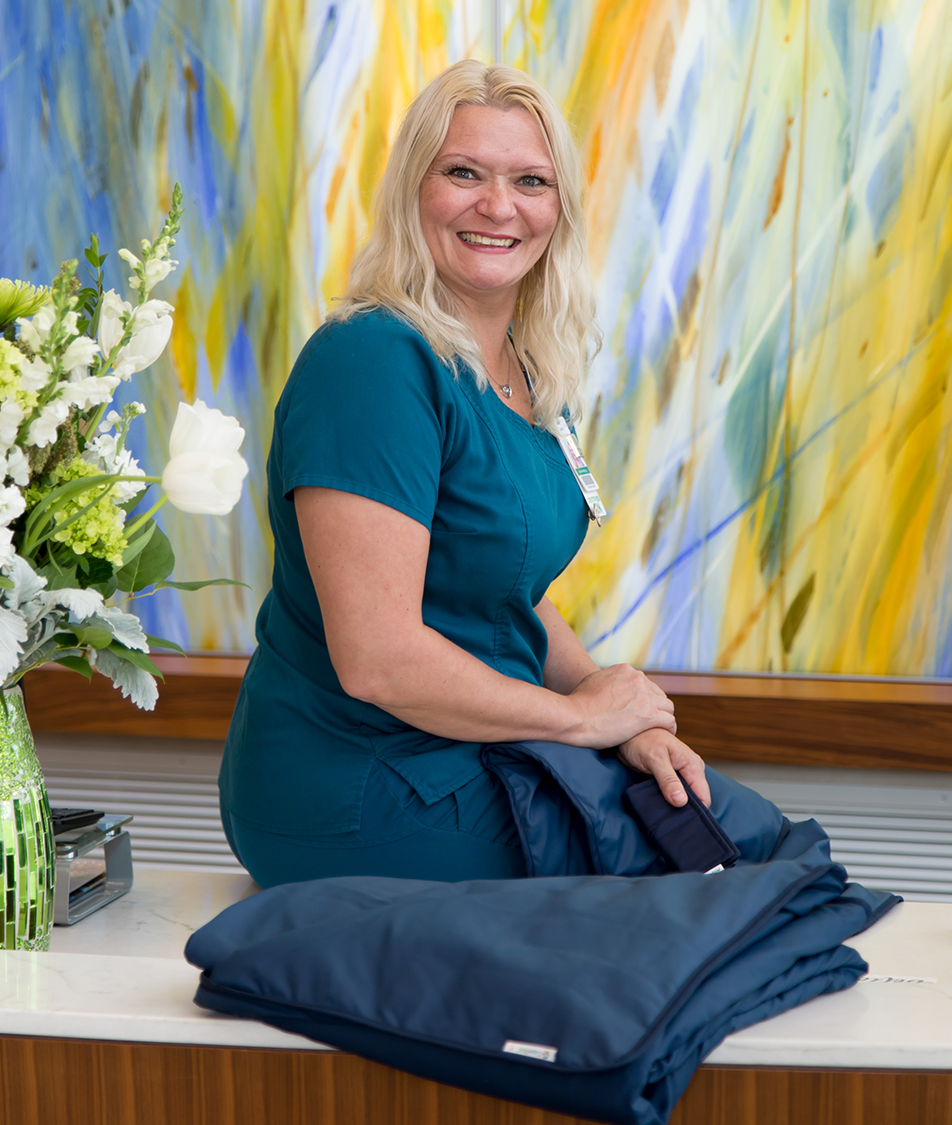
Last year, Jaime Vinson, BSN, RN, HN-BC, RYT, holistic nursing system coordinator, launched a pilot study to assess if a weighted blanket could reduce anxiety in outpatient infusion center patients. We asked her to share more about her inspiration, efforts and hopes for the future of care.
How did this project come about?
I was working in Inpatient Rehabilitation at Parkview Hospital Randallia. I often worked with traumatic brain injury (TBI) patients. My brother had a brain injury, so I have always had a soft spot in my heart for that patient population. TBI patients often remind me of people with Autism Spectrum Disorder. One young boy in particular, a brain injury patient, was overstimulated, and I thought he could benefit from a weighted blanket in the same way that those on the Autism spectrum did. I asked my manager about looking more deeply into getting a weighted blanket for the unit and she agreed.
I was also pursing my BSN at that time. After writing a paper on the topic, one of my instructors encouraged me to pursue the idea and do a real nursing research study. Later that year, I signed up for Parkview’s Nursing Research and Evidence-based Practice Fellowship. During the fellowship class, I shifted my patient population from its focus on TBI patients, to patients in the outpatient infusion center setting. There were more patients available this way, which allowed me to complete the pilot study faster.
I knew we needed to have weighted blankets in the hospital as a holistic nursing tool. It became my mission to implement them into the healthcare system.
How did you go about setting up the study?
I took the Nursing Research and Evidence-based Practice Fellowship class at Parkview. With the help of great mentorship, the proposal passed the Institutional Review Board (IRB) in April 2018.

What were the criteria?
The pilot study involved 58 patients 18 years or older receiving at least two chemotherapy infusion treatments at the Parkview Cancer Institute’s outpatient infusion center. The participants were separated into two randomized groups. One group received weighted blanket therapy at their first two treatments. The other group received weighted blanket therapy at their first treatment and then the standard treatment at their second treatment.
The study was a randomized-crossover study of 60 patients serving as their own control. Participants needed to be over 18 and receiving at least their first two chemotherapy in fusions at our outpatient infusion center. They were randomized to one of two groups, those using the weighted blanket their first infusion but not their second, and those who would use the weighted blanket their second infusion but not their first. Participants were required to use the weighted blanket for the first 15 minutes after it was donned but were allowed to put it on and off at their discretion thereafter.
What were you measuring?
Anxiety with a Visual Analog Scale (VAS) (a 100mm line where the participants marked with a slash where they feel they fell on that line from having no anxiety to very anxious) and anxiety with the State-Trait Anxiety Inventory- Adult Short Form (SATIAD-Y1), We also measured vital signs, collected comments from patients and nurses, and asked the participants to keep track of when they took off or put the weighted blanket back on.
What did you hope to achieve with your study?
I wanted to see if there was a reduction in anxiety, enough so that I could do further research and implement quality improvement projects with weighted blankets here at Parkview. If the patient/nurse can use this tool to help calm the patient, maybe there would be less need for some medications.
It also gives the patient a sense of control. They can remove the blanket if they do not like it, unlike medications, which take time to wear off if they do not like the way the medication made them feel. I’m striving to implement a low-tech holistic nursing solution with a big impact.
I also want to change the guidelines of how weighted blankets are “weighted”. We need to be measuring the amount of deep touch pressure being delivered, not the total weight of the blanket. I literally looked across the country for a manufacturer who could make or had what I needed. None could answer my questions about the amount of pressure in their product. They all wanted to talk to me about the total weight, and most suggested that I use at least a 30-pound blanket. Personally, I see a 30-pound blanket as a restraint.
Then I met a manufacture right here in Fort Wayne who, not only understood everything I was talking about, but was also already making the blanket I could use in my study. CapeAble gave me my first therapeutic medical-grade weighted blanket I could take in to have approved by our health system’s infection control manager for use on multiple patients. CapeAble also solved the barrier of cleaning the blanket that I so very much dreaded. The blankets are cleaned the same way we clean the mattresses on our hospital beds.
Was there any financial support for your study?
Initially, CapeAble donated three blankets for me to trial in the hospital. Then Amy Poole, director, Oncology Services, asked The HOPE Foundation to donate enough money for us to purchase five medical-grade weighted blankets from CapeAble.
What did you find from the study?
I learned two important things: 1) These patients experienced a reduction in anxiety through weighted blanket therapy, and 2) You can effectively use the same blanket on patients of all weights. It is not the total weight of the blanket that matters, it is the amount of Deep Touch Pressure (DTP) the blanket delivers (ounces per square inch). This means that there is no need for multiple “weights”. We can use a standard weight medical-grade therapeutic weighted blanket for patients of many shapes and sizes. This will change the current guidelines of the weighted blanket industry.
What will this mean for the future of patient care?
I the American Holistic Nurses Association Research Grant Award this year and have also received funding from the Parkview Foundation. The next step will be to research whether weighted blankets can reduce pre-surgical pain and anxiety, and post-surgical restlessness, nausea and vomiting. Quality Improvement (QI) projects using weighted blankets are also underway here at Parkview. Nurses and patients are seeing amazing results.
I am always hearing the testimony of how well the weighted blanket has worked in all sorts of scenarios. I would like to be the first hospital to implement weighted blankets as a standard of care for all patients in the health system.
What surprised you the most about the process?
I was amazed at the amount of synchronicity that has happened in my story. Who would have guessed that the manufacturer I needed was here in Fort Wayne or that I would have an Evidence-based Practice Fellowship available to me? I was ready to give up so many times, but I am truly blessed by those who have supported me, believed in me, mentored me, and helped me along the way. Without my family and friends, my CapeAble family, my AHNA family, and my Parkview family, none of this would be possible.



